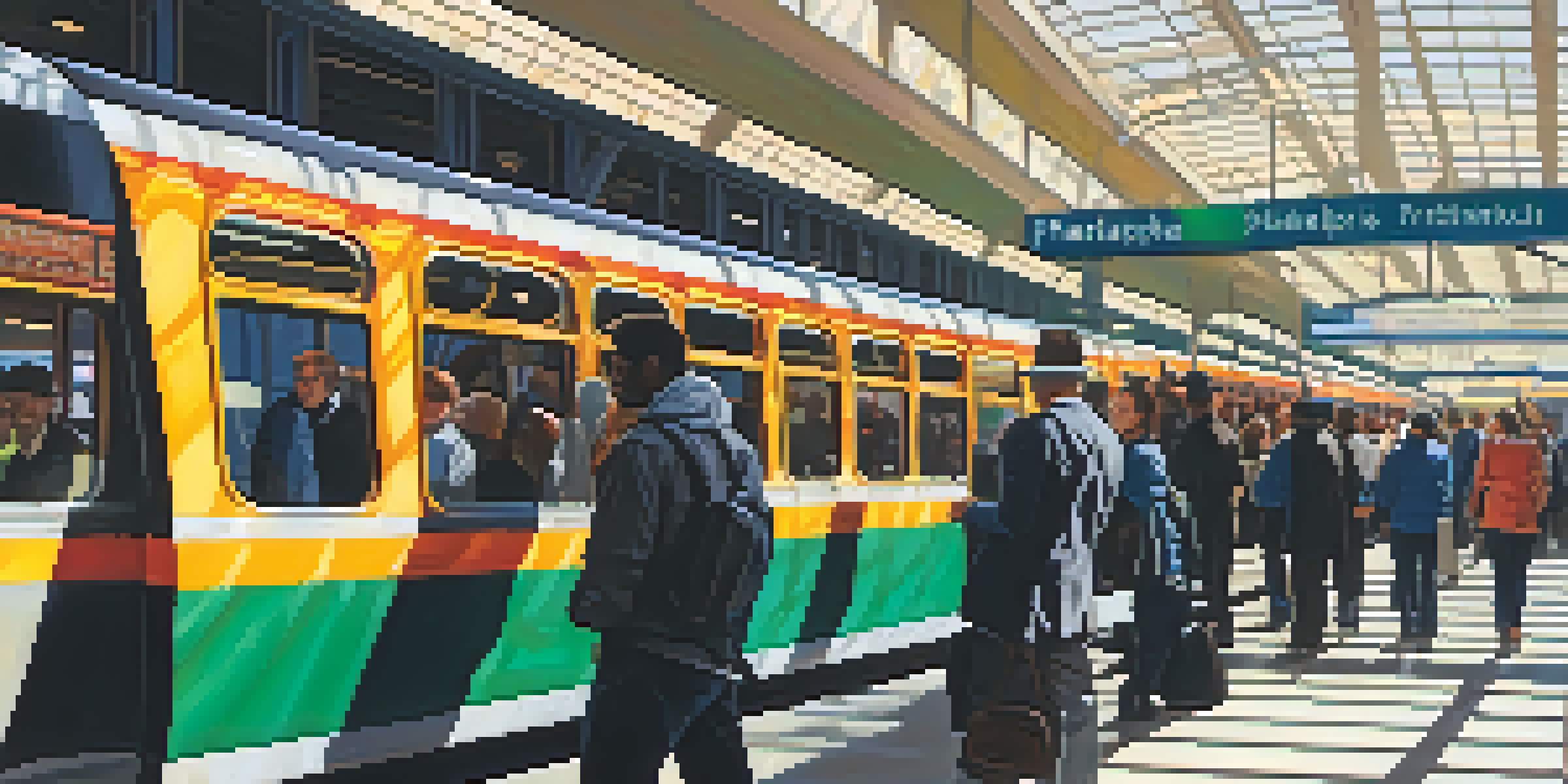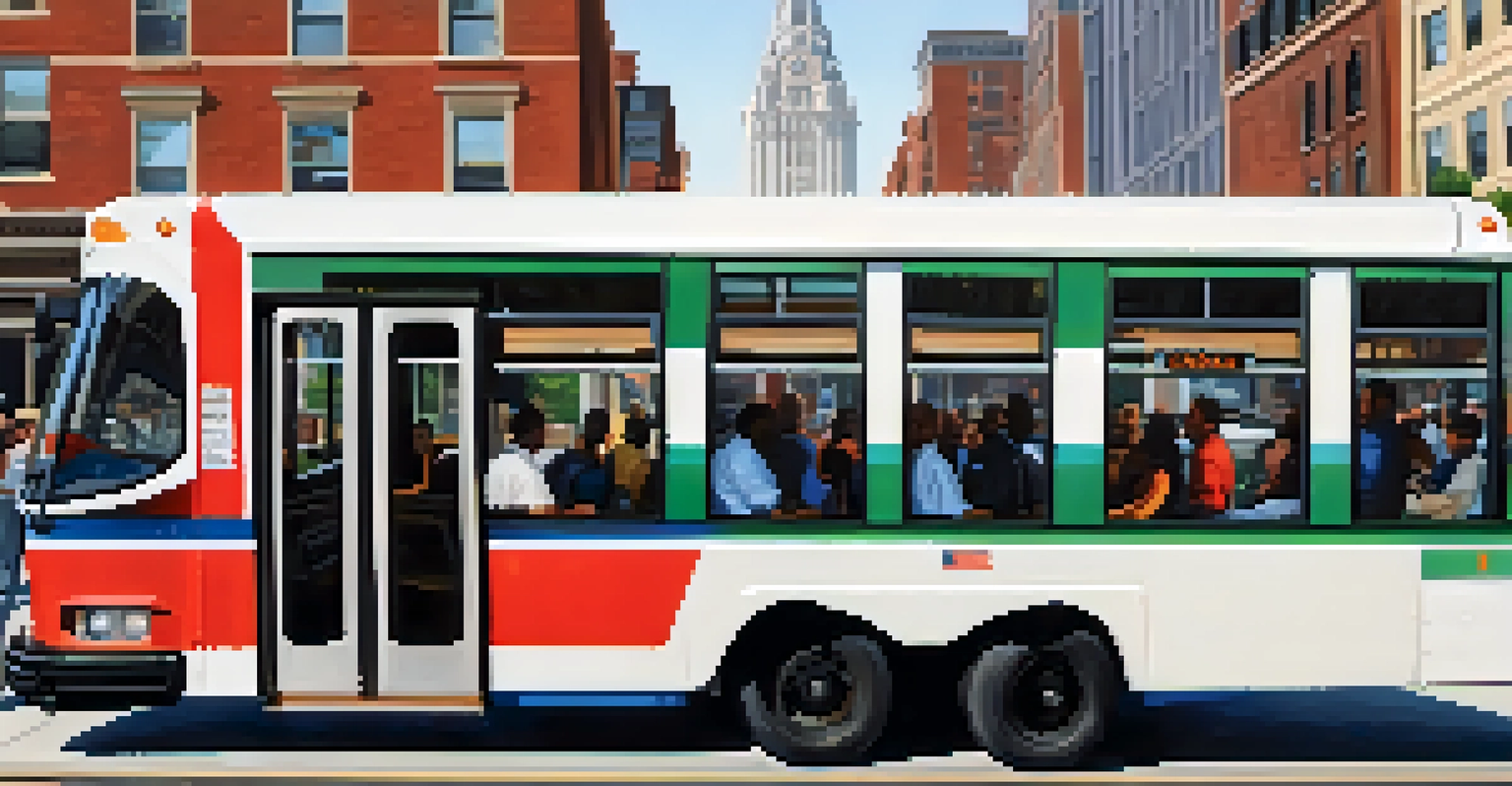Public Transportation and Economic Growth in Philadelphia

The Link Between Transit and Economic Development
Public transportation is more than just a way to get from point A to point B; it’s a vital engine driving economic growth in Philadelphia. As residents and visitors utilize the transit system, they access jobs, education, and services, which enhances the local economy. This connectivity fosters a vibrant community where businesses thrive and new ventures emerge.
Public transportation is the backbone of a thriving economy; it connects people to opportunities and fosters community growth.
In Philadelphia, public transit helps reduce travel times, making it easier for individuals to commute to work and for businesses to attract talent. For example, the Southeastern Pennsylvania Transportation Authority (SEPTA) provides essential services that link neighborhoods to commercial hubs, significantly impacting employment rates. The increased accessibility encourages local spending and helps maintain a diverse economy.
Moreover, studies show that areas with robust public transportation options tend to experience higher property values. This trend indicates that investments in transit infrastructure can catalyze neighborhood revitalization, making Philadelphia a more attractive place for both residents and businesses alike.
Job Access and Economic Mobility
One of the most significant benefits of public transportation in Philadelphia is its ability to connect individuals to job opportunities. Many low-income residents rely on transit to access employment options that may otherwise be out of reach. This access is crucial for promoting economic mobility and reducing poverty levels in the region.

For example, the expansion of transit routes into underserved areas has increased job accessibility for many Philadelphians. This improvement means that people can seek employment in various sectors, from healthcare to technology, without being limited by their transportation options. Consequently, a more skilled workforce emerges, benefiting the economy as a whole.
Transit Drives Economic Growth
Public transportation in Philadelphia is a critical engine for economic development, connecting residents to jobs, education, and services.
Additionally, transit-oriented development initiatives encourage businesses to establish themselves near public transportation hubs. This strategy not only creates more jobs but also stimulates local economies, fostering a sense of community and collaboration among residents and businesses.
Reducing Traffic Congestion and Pollution
Public transportation plays a significant role in alleviating traffic congestion in Philadelphia, a city notorious for its busy streets. By encouraging more people to use buses, trains, and subways, we can reduce the number of cars on the road. This shift not only improves travel times but also enhances the overall quality of life for residents.
A city’s public transit system is not just a means of transportation; it’s a reflection of its values and priorities.
Moreover, fewer vehicles on the road contribute to a decrease in air pollution, which is vital for maintaining a healthy urban environment. Public transit systems are generally more energy-efficient than individual cars, and as more residents opt for these options, Philadelphia can work towards its sustainability goals. Cleaner air and reduced traffic congestion create a more inviting atmosphere for businesses and tourists alike.
In essence, investing in public transportation not only supports economic growth but also promotes a greener future for the city. As Philadelphia continues to expand its transit options, the benefits will ripple through the community, making it a more livable place for everyone.
Investment in Infrastructure and Its Returns
Investment in public transportation infrastructure is essential for Philadelphia's long-term economic success. Upgrading transit systems requires significant funding, but the returns can be substantial. Improved infrastructure can lead to increased ridership, which translates into higher revenues and better services for the community.
Moreover, when the city invests in transit infrastructure, it often attracts additional funding from state and federal sources. These funds can be used to expand services, improve facilities, and maintain the existing network. As a result, a well-maintained and modern transit system can become a catalyst for further economic development.
Accessibility Boosts Job Opportunities
By expanding transit routes, Philadelphia enhances job access for low-income residents, promoting economic mobility and a skilled workforce.
Additionally, as public transit infrastructure improves, it can stimulate private investment in surrounding areas. Developers are more likely to invest in neighborhoods with reliable transit options, leading to new housing, retail, and commercial spaces that can create jobs and boost the local economy.
Public Transit and Tourism in Philadelphia
Philadelphia's public transportation system is also integral to its tourism industry. Tourists rely on transit options to explore the city’s rich history, cultural attractions, and vibrant neighborhoods. By providing easy access to landmarks like the Liberty Bell and the Philadelphia Museum of Art, public transit enhances the visitor experience.
Many tourists prefer using public transportation because it offers a cost-effective way to navigate the city. With SEPTA’s broad network, visitors can conveniently reach key destinations without the hassle of parking or traffic. This accessibility not only benefits tourists but also boosts local businesses that rely on the influx of visitors.
Furthermore, as more tourists use public transit, it creates a sense of community pride. A well-functioning transit system reflects positively on the city, encouraging repeat visits and word-of-mouth recommendations. By investing in public transit, Philadelphia can continue to attract tourists and stimulate its economy.
Challenges Facing Public Transit in Philadelphia
Despite the many benefits of public transportation, Philadelphia faces several challenges in maintaining and improving its transit system. Aging infrastructure, limited funding, and rising operational costs pose significant hurdles for SEPTA and city planners. These challenges can hinder the potential growth and efficiency of public transportation services.
Additionally, ensuring equitable access to transit services is a persistent issue. Some neighborhoods may not have direct access to public transportation, which can create disparities in job access and economic opportunities. Addressing these inequities requires thoughtful planning and investment to ensure that all residents benefit from the transit system.
Sustainable Transit for a Greener City
Investing in public transit reduces traffic congestion and pollution, contributing to a healthier urban environment and a more attractive city.
To overcome these challenges, collaboration between government agencies, community organizations, and transit authorities is crucial. By working together, Philadelphia can develop innovative solutions that enhance public transportation and, in turn, support economic growth across the city.
The Future of Public Transportation in Philadelphia
Looking ahead, the future of public transportation in Philadelphia is filled with potential. With ongoing investments in infrastructure and technology, the city can enhance the efficiency and reliability of its transit system. Innovations like electric buses and smart transit solutions can further improve sustainability and user experience.
Moreover, engaging the community in transit planning is essential for creating a system that meets the needs of all residents. By gathering input from diverse groups, planners can develop solutions that foster inclusivity and accessibility. This approach ensures that the benefits of public transportation are felt throughout the city.

Ultimately, a strong public transportation system will be key to Philadelphia’s economic growth. As the city continues to invest in and improve its transit options, it can create a more connected, vibrant, and prosperous community for everyone.